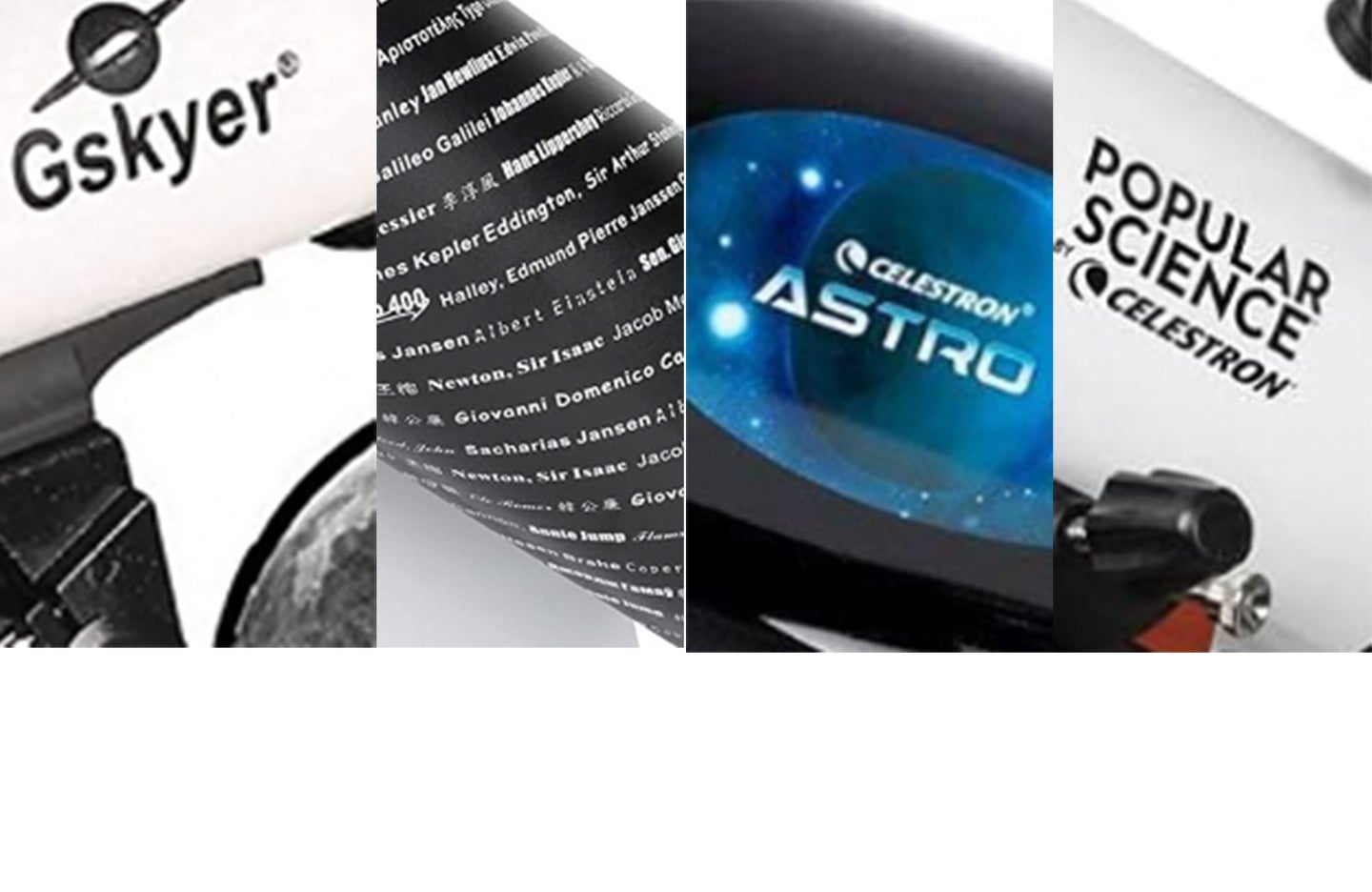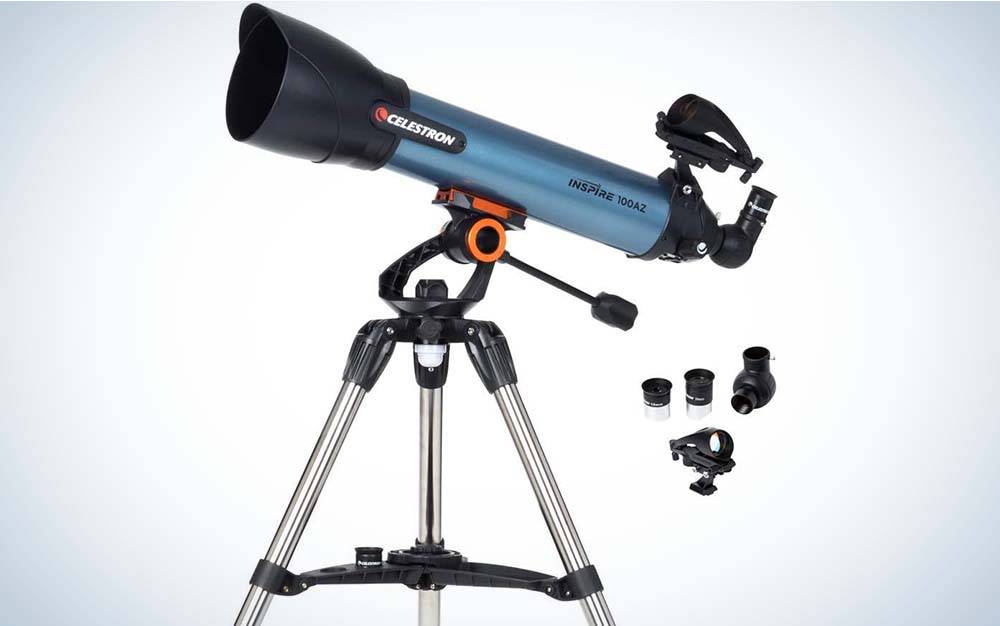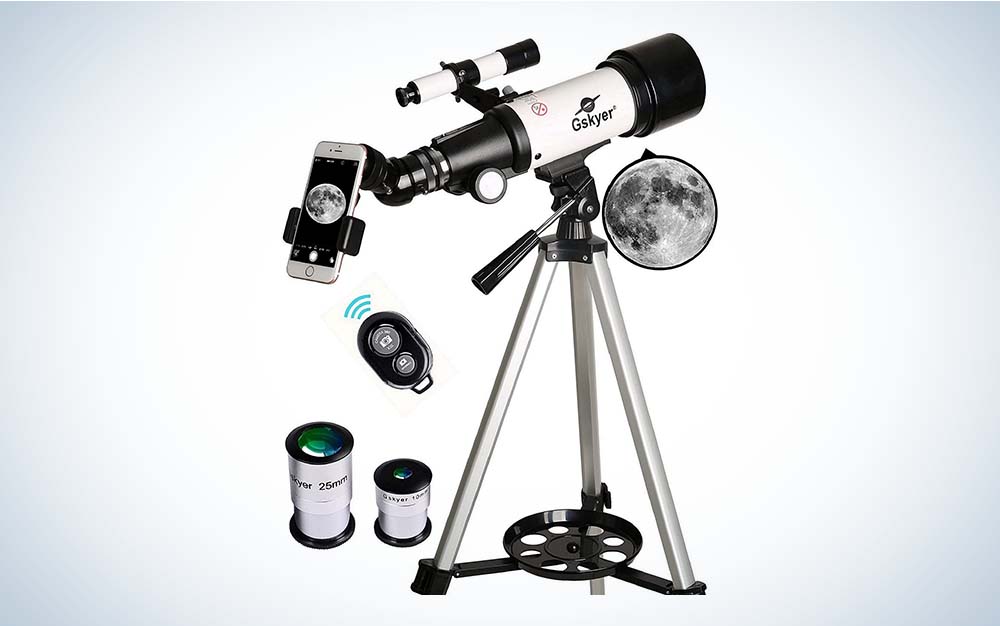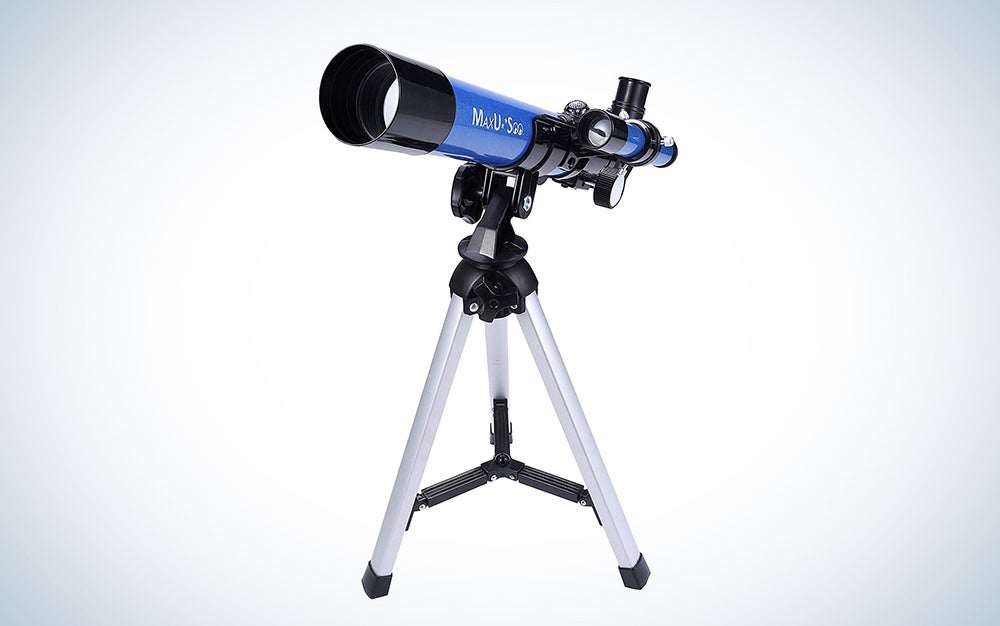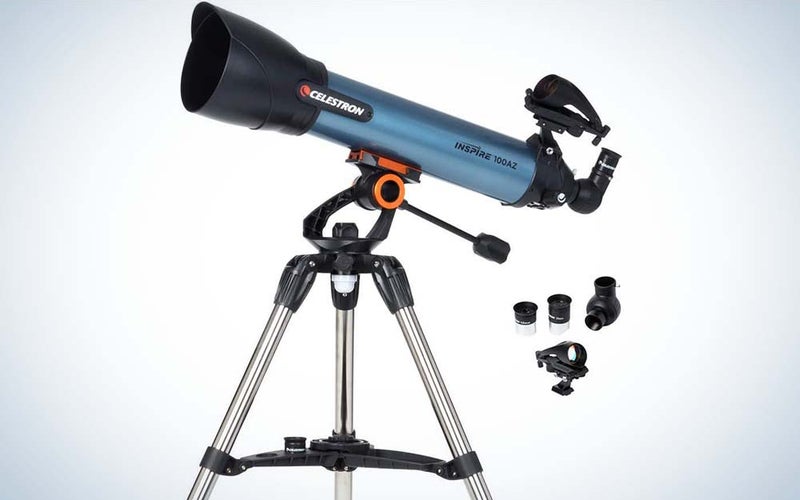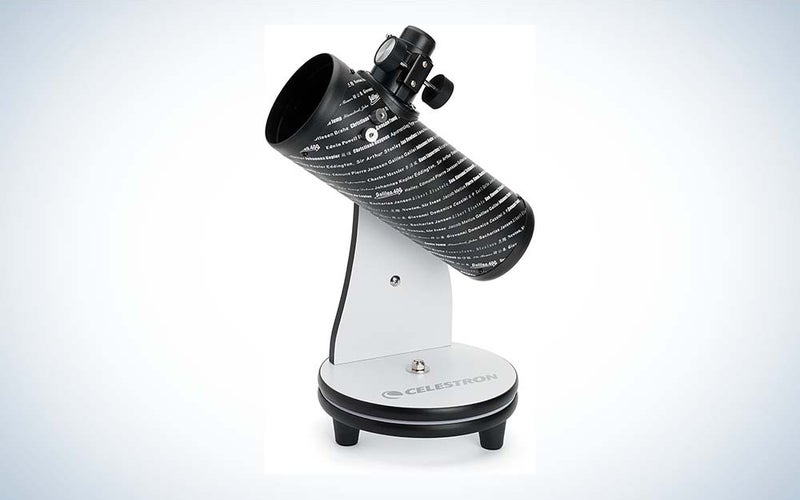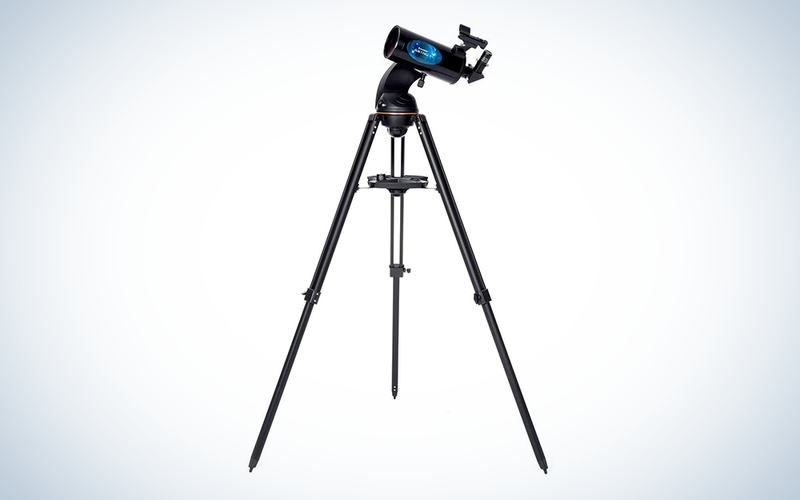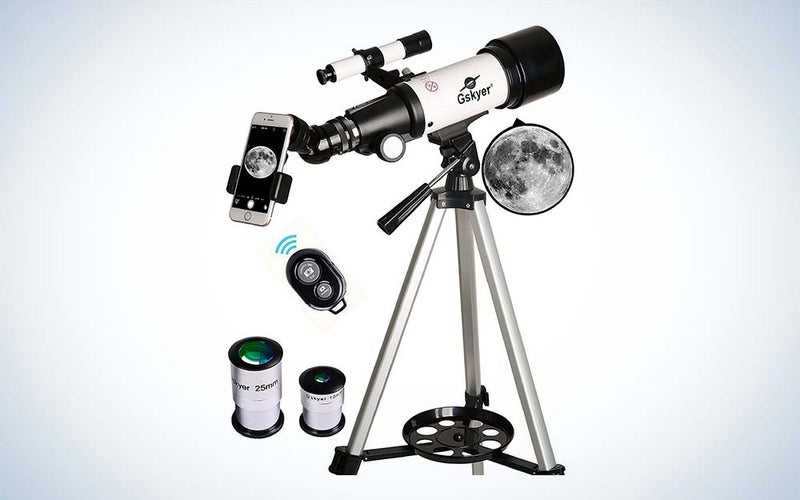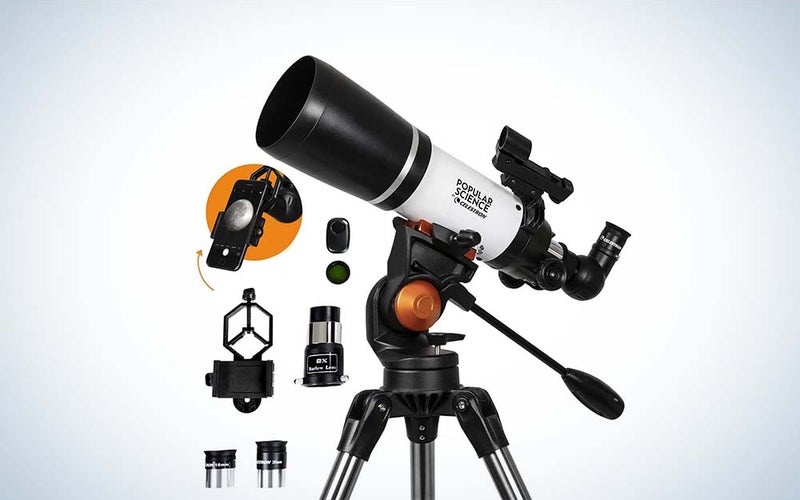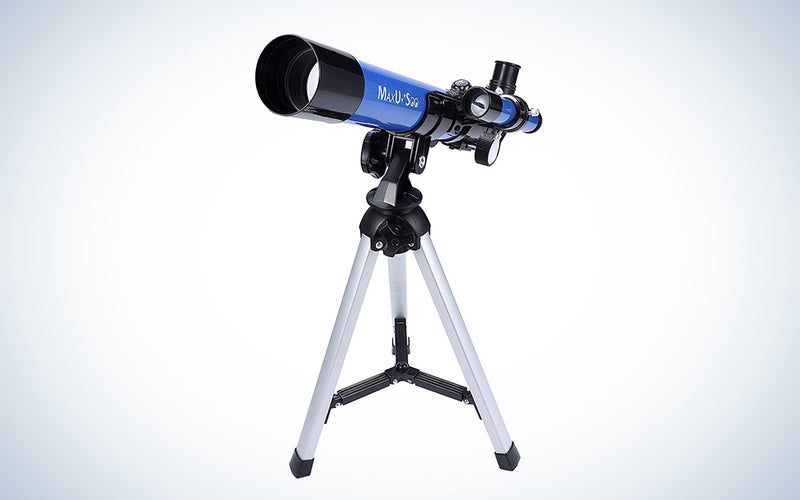We may earn revenue from the products available on this page and participate in affiliate programs. Learn more ›
While trips to the Moon may not be commonplace yet, you can foster curiosity about the universe by letting kids see the lunar surface and the rings of Saturn up close with a telescope for kids. It’s one thing to learn about the Moon in school, and it’s another thing to see it up close. The best telescopes for kids are designed for amateur astronomers, and can provide night after night of out-of-this-world entertainment.
- Best overall: Celestron Inspire 100AZ
- Best for young kids: Celestron FirstScope 76 Tablestop Telescope
- Best for older kids: Celestron Astro Fi 102 WiFi Maksutov Wireless Reflecting Telescope
- Best for travel: Gskyer 70mm Aperture 400mm AZ Mount Astronomical Refractor Telescope
- Best for smartphone photography: POPULAR SCIENCE AstroMaster 80mm – Portable Refractor Telescope
- Best budget: MaxUSee Kids Telescope 400x40mm with Tripod & Finder Scope
How we chose the best telescopes for kids
Popular Science covers the latest developments in astronomy, from stunning images from the James Webb Space Telescope’s discovery of its first exoplanet to meteor showers you can see from your backyard. Telescopes are a great way to help kids explore the galaxy and see the planets up close. But they can also be complicated instruments with many moving parts for the uninitiated.
In compiling our list of recommendations for the best telescopes for kids, we considered models from trusted brands like Celestron, optical quality and magnification, ease of set up and use, supplemental educational tools that explain what to look for in the night sky, durability, and portability. We also weighed user reviews, what kids look for at different ages, and prices.
The best telescopes for kids: Reviews & Recommendations
Looking for a telescope for the first time can be a daunting experience. Many of the considerations are the same finding telescopes for adults. Figuring out what type of telescope is best for your needs, what aperture you should look for, and the relationship between focal length and magnification are all important factors to consider. The best telescopes for kids should also be durable and easy to use. We break down what you should look for and our picks so you can compare telescopes and find the best option for your family.
Best overall: Celestron Inspire 100AZ
Celestron
Specs
- Weight: 12.4 pounds
- Eyepieces: 10mm and 20mm
- Aperture: 100mm
- Type: Refractor
Pros
- Good for both stargazing and birdwatching
- Wide aperture for better focus
- Comes with smartphone adapter
- Plenty of training resources
Cons
- Some users say the build quality is not great
Celestron has been making telescopes for nearly 60 years. Its Inspire AZ100 is a great tool for older kids (and adults) to start stargazing at night and observing objects on Earth during the day.
This short refractor telescope is a good telescope for beginners as it’s easy to set up and doesn’t require any special tools. Its short optical tube of 436mm provides a wide field of view, while its higher 100mm aperture allows aspiring astronomers to focus on the planets, moons, and stars. At 12.4 pounds, this telescope is relatively lightweight, and it comes with a tripod that’s easy to adjust. The AZ1000’s alt-az mount allows users to move the telescope up and down and pan left and right.
The 10mm and 20mm eyepieces increase magnification by 33 times and 66 times, respectively. A finderscope makes it easier for beginning astronomers to spot the surface of the Moon. And your purchase also gives you access to Celestron’s Starry Night software, which teaches kids about what they see in the night sky. This telescope is also equipped with a smartphone adapter that allows kids to capture images of both the planets and wildlife.
Best for young kids: Celestron FirstScope
Celestron
Specs
- Weight: 4.5 pounds
- Eyepieces: 4mm and 20mm
- Aperture: 76mm
- Type: Dobsonian/Newtonian
Pros
- Easy to use
- Portable
- Less expensive
Cons
- Small aperture
Designed for kids from ages 4 to 8, Celestron’s FirstScope is an ideal introductory telescope. Inspired by Galileo, this telescope features the names of he and other esteemed astronomers through the ages on its optical tube. This telescope comes with 20mm and 4mm eyepieces that result in magnification of 15 times and 75 times, respectively. The FirstScope is also light and easy to transport at 4.5 pounds. Its tabletop design makes it simple to set up on level surfaces outdoors. It’s a good telescope for a 5-year-old kid, and when the child is done stargazing, it looks great on a bookshelf.
Best for older kids: Celestron Astro Fi 102 WiFi Maksutov Wireless Reflecting Telescope
Celestron
Specs
- Weight: 16.8 pounds
- Eyepieces: 25mm, 10mm
- Aperture: 125mm
- Type: Schmidt-Cassegrain
Pros
- Works with smartphones and iPads
- WiFi-enabled
- Lens cap doubles as a smartphone adapter
Cons
- Challenging to use if WiFi connection is spotty
- Some users report difficulty focusing
To get kids who are always on their devices interested in the Andromeda Galaxy, consider the Celestron Astro Fi 102 WiFi Maksutov Wireless Reflecting Telescope. Kids can control the WiFi-enabled telescope using an iPhone, iPad, or Android device and Celestron’s SkyPortal app, making this a good teen telescope. Instead of searching the night sky for planets, teens can use this telescope’s interactive sky map to tap the object they want to see on their screen. Then the telescope will move to find the object and focus upon it.
Set up is easy, and at 16 pounds with an adjustable tripod, this telescope is quite portable. Its two eyepieces (25mm and 10mm) provide magnification of 50 times and 125 times, respectively. That power will help kids locate the rings of Saturn, the red spot on Jupiter, the craters on the Moon at night, and wildlife and birds during the day. And the lens cap doubles as a smartphone adapter so that kids can show off images of their cosmic and terrestrial explorations.
Best for travel: Gskyer 70mm Aperture 400mm AZ Mount Astronomical Refractor Telescope
Gskyer
Specs
- Weight: 5.73 pounds
- Magnification: 25mm, 10mm
- Aperture: 70mm
- Type: Refractor
Pros
- Lightweight
- Strong magnification
- Comes with smartphone adapter
Cons
- Some users say its poorly made
- May not locate celestial objects as well as other telescopes
This beginner’s telescope from Gskyer is designed for portability. This compact model weighs just under 6 pounds and comes with a travel case and an adjustable tripod so kids can take it on the go. The magnification power of the two eyepieces (25mm and 10mm) increase magnification by 16 times and 40 times, respectively, which can then be tripled using the included 3x Barlow lens. The Gskyer also comes with a smartphone eyepiece adapter so your kids can take photos of their discoveries, making it a solid telescope for 10-year-olds and other kids around that age.
Best for smartphone photography: POPULAR SCIENCE AstroMaster 80mm – Portable Refractor Telescope
Celestron
EDITOR’S NOTE: Popular Science has teamed up with Celestron on a line of products. The decision to include this model in our recommendations was made by our reviewer independently of that relationship, but we do earn a commission on its sales—all of which helps power Popular Science.
Specs
- Weight: 10 pounds
- Magnification: 20mm and 10mm
- Aperture: 70mm
- Type: Refractor
Pros
- High-quality optics
- Can operate it remotely
- Comes with educational software
Cons
- Some users said components arrived broken
If your kid is a budding photographer who’s looking to capture images of the planets, the AstroMaster 80mm is a great option. A collaboration between Celestron and Popular Science, this telescope combines high-quality optics, including an 80mm objective lens, with a smartphone adapter that allows users to take photos and videos of the Moon, planets, and birds through the eyepiece. This refractor model comes with two eyepieces (20mm and 10mm) and a Barlow lens that doubles its magnification power. It also features an erect image diagonal that allows you to use it to spot wildlife and other terrestrial objects during the day.
This telescope allows you to connect via Bluetooth and control the shutter release remotely on both iOS and Android phones. It’s also easy to assemble and super portable at 10 pounds. And kids can get a primer on the night sky with Celestron’s Starry Night Astronomy software, which provides sky maps and details about thousands of celestial objects.
Best budget: MaxUSee Kids Telescope 400x40mm with Tripod & Finder Scope
MaxUSee
Specs
- Weight: 1.9 pounds
- Eyepieces: 20mm, 12.5mm, 6mm
- Aperture: 40mm
- Type: Refractor
Pros
- Lightweight
- Inexpensive
- Comes with viewfinder scope
Cons
- Lenses not powerful
- No connectivity
The maps of the moon and stars are a big hit with kids, and adults will love the price of these budget-friendly telescopes. With easy assembly and included moon filter, the MaxUSee telescope is a good tool to get your child stargazing. That said, its eyepieces are not very powerful and it doesn’t come with a lot of features, so if having a good quality telescope that you can use for years is important, this may not be the best option.
Things to consider before purchasing a telescope for kids
If you’ve purchased cameras before, some terminology around lenses and light will be familiar. While telescopes can be incredibly intricate, when it comes to finding the best telescopes for kids, look for options that are easy to set up and use, durability, and lightweight for easy portability.
Type of telescope
There are three main types of telescope: refracting, reflecting, and catadioptric.
Refractor: These telescopes use both an objective lens and an eyepiece to display an image. Light enters the telescope and is bent or refracted as it travels through the optical tube. The eyepiece then magnifies the light and straightens out the image for the viewer.
Reflector: Reflecting telescopes use mirrors to bring an image into focus. These telescopes typically have a primary mirror opposite the aperture, where light comes into the telescope, and a secondary mirror. The light is reflected from the second mirror toward the eyepiece for the viewer to see the image.
Catadioptric: These telescopes are designed with both lenses and mirrors to show an image, combining refraction and reflection. One of the categories of this type of telescope is known as Schmidt-Cassegrain.
Focal length, magnification, and aperture
The focal length of a telescope is the distance between where the telescope’s main lens or mirror and where light enters the telescope. It can range between 300 and 4,000 millimeters. The shorter the focal length, the wider the field of view. Conversely, higher focal lengths provide greater magnification to focus on a specific object.
To find out the magnification of a telescope using a specific eyepiece, divide the focal length of the optical tube by the eyepiece.
Aperture: A telescope’s aperture indicates the diameter of the objective lens or mirror in millimeters. The larger the aperture, the more light the telescope can let in, making images brighter and easier to see.
Mounts
The three categories of mounts of telescopes are Altazimuth, Dobsonian, and Equatorial. Alt-az mounts, as they are also known, refer to the horizontal and vertical axes. They allow users to move the telescopes left and right and up and down on a tripod. Dobsonian mounts are a type of alt-az mount that are designed to support heavy telescopes with large apertures.
Equatorial mounts are used with more sophisticated telescopes. One of their axes aligns with Earth’s rotation axis. These mounts are designed for long-term observation and astrophotography.
Ease of use
When considering what telescope to buy, look for options that will be easy for them to operate. Keep an eye out for models that are easy to set up and come with tripods. Many options are also lightweight and come with a carrying case or backpack for easy portability, such as the Gskyer 70mm Aperture 400mm AZ Mount Astronomical Refractor Telescope.
Age of your child
Kids age 4 to 8 starting stargazing will do well with a tabletop model with simple controls, such as the Celestron FirstScope. Meanwhile, older kids with some experience will appreciate the flexibility of telescopes with smartphone adapters that let them take photos and images of their cosmic finds, or they can use to take photos with their smartphone and the Celestron Astro Fi 102 WiFi Maksutov Wireless Reflecting Telescope, which they can operate remotely using their smartphone or an iPad.
FAQs
Q: What type of telescope is best for kids?
The best type of telescope for kids depends on their age. For younger children, simple, tabletop telescopes with easy-to-use controls are great for new stargazers. As kids age, they can use models with more advanced features, such as several eyepieces, accompanying educational software, and smartphone adapters.
Q: How much does a telescope for kids cost?
Telescopes for kids can range from around $20 for budget-friendly models with limited features to more than $350 for telescopes for older children that have high-quality optics, lots of supporting educational material, and are made from durable materials.
Q: Can a kid’s telescope be used to see planets?
Yes, a kid’s telescope can be used to see planets. At a basic level, most kids’ telescopes will allow them to see the surface of the Moon. More sophisticated models with more magnification power and locating tools can help kids see Jupiter and Saturn.
Q: Are kids’ telescopes OK for amateur astronomy?
Kids’ telescopes are great for amateur astronomy. However, when selecting a kids ‘ telescope, just be mindful of the child’s age and capabilities. And be sure to take advantage of the finderscopes and any accompanying educational materials that will help your child learn more about thousands of objects in the night sky.
Final thoughts on the best telescopes for kids
- Best overall: Celestron Inspire 100AZ
- Best for young kids: Celestron FirstScope 76 Tablestop Telescope
- Best for older kids: Celestron Astro Fi 102 WiFi Maksutov Wireless Reflecting Telescope
- Best for travel: Gskyer 70mm Aperture 400mm AZ Mount Astronomical Refractor Telescope
- Best for smartphone photography: POPULAR SCIENCE AstroMaster 80mm – Portable Refractor Telescope
- Best budget: MaxUSee Kids Telescope 400x40mm with Tripod & Finder Scope
If you’re looking to give your children an appreciation for the galaxy, these telescopes for kids can help them see the stars and the planets close up. These models are easy to assemble and are designed with features that kids will appreciate, such as the ability to take photos with their phones. You’ll be glad you have one of the best telescopes on hand for the next cosmic event.
Why trust us
Popular Science started writing about technology more than 150 years ago. There was no such thing as “gadget writing” when we published our first issue in 1872, but if there was, our mission to demystify the world of innovation for everyday readers means we would have been all over it. Here in the present, PopSci is fully committed to helping readers navigate the increasingly intimidating array of devices on the market right now.
Our writers and editors have combined decades of experience covering and reviewing consumer electronics. We each have our own obsessive specialties—from high-end audio to video games to cameras and beyond—but when we’re reviewing devices outside of our immediate wheelhouses, we do our best to seek out trustworthy voices and opinions to help guide people to the very best recommendations. We know we don’t know everything, but we’re excited to live through the analysis paralysis that internet shopping can spur so readers don’t have to.
